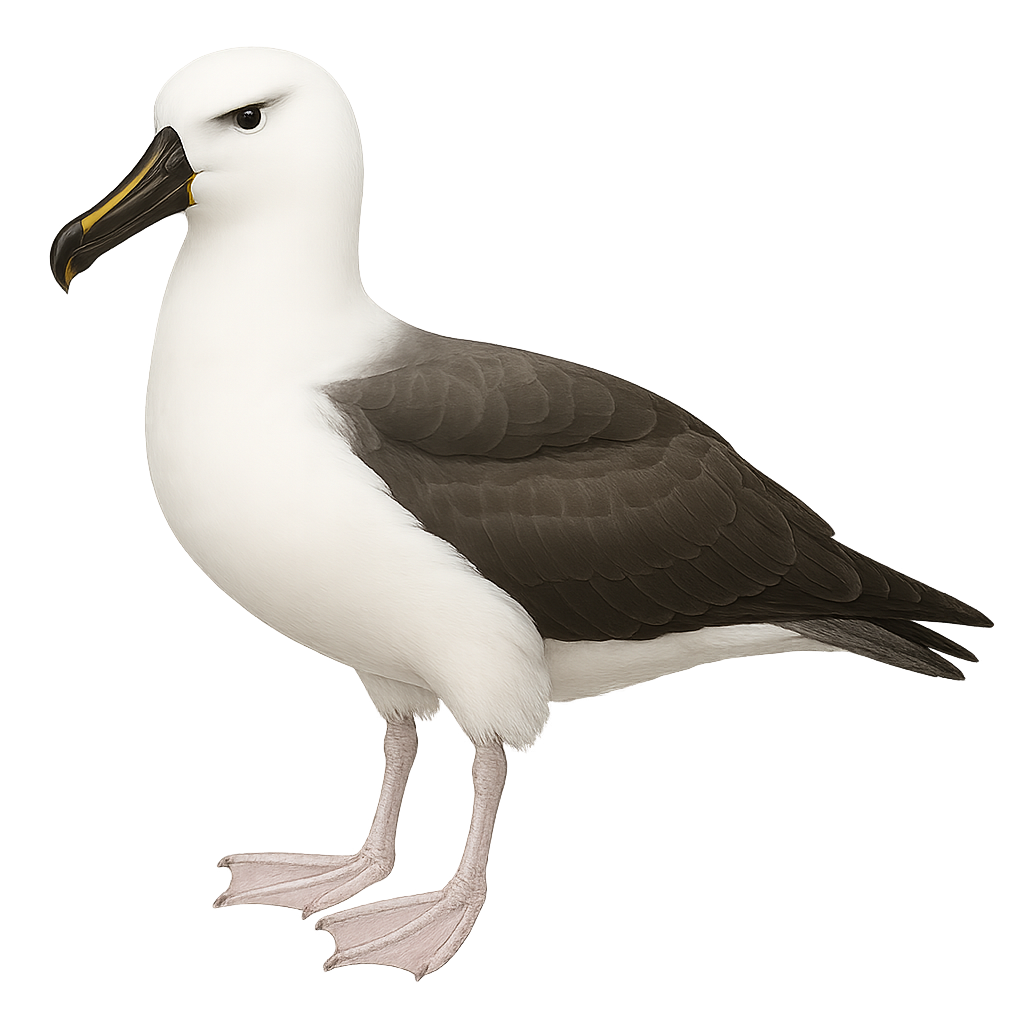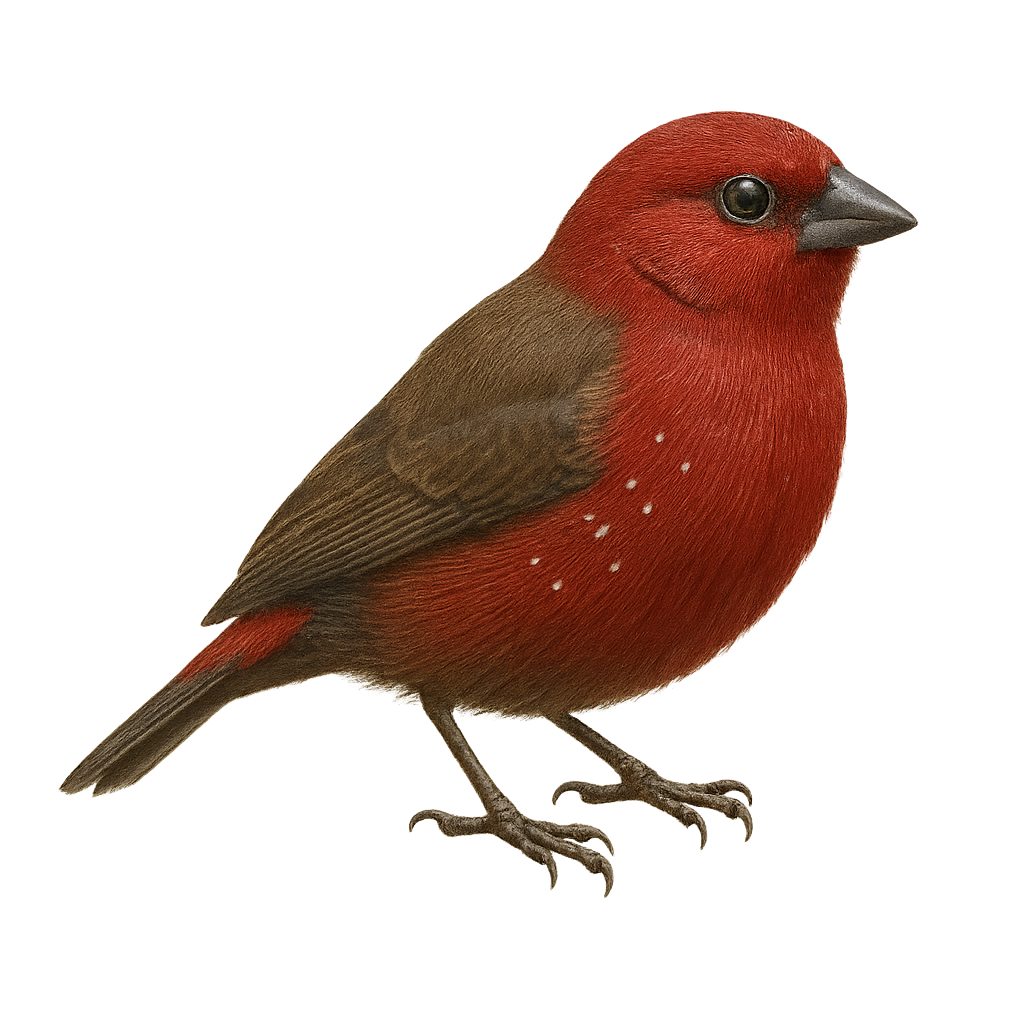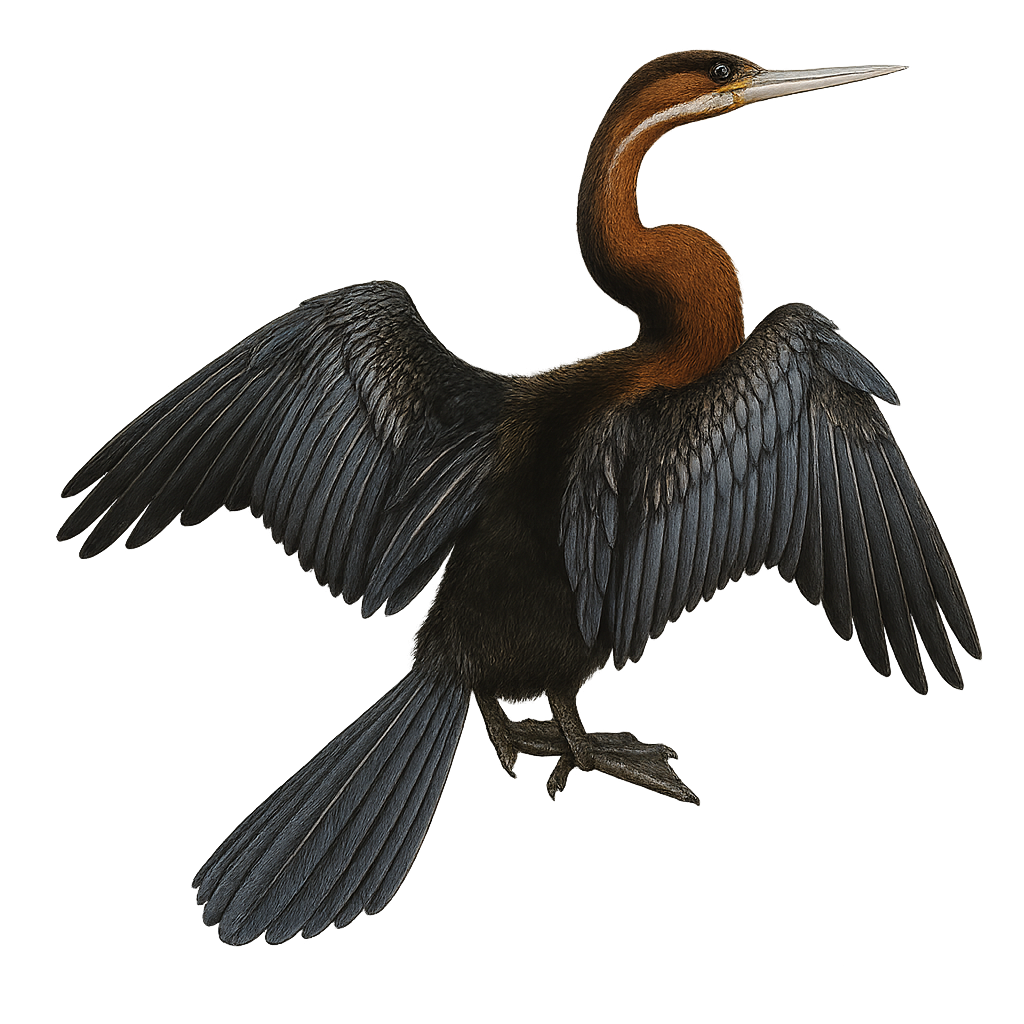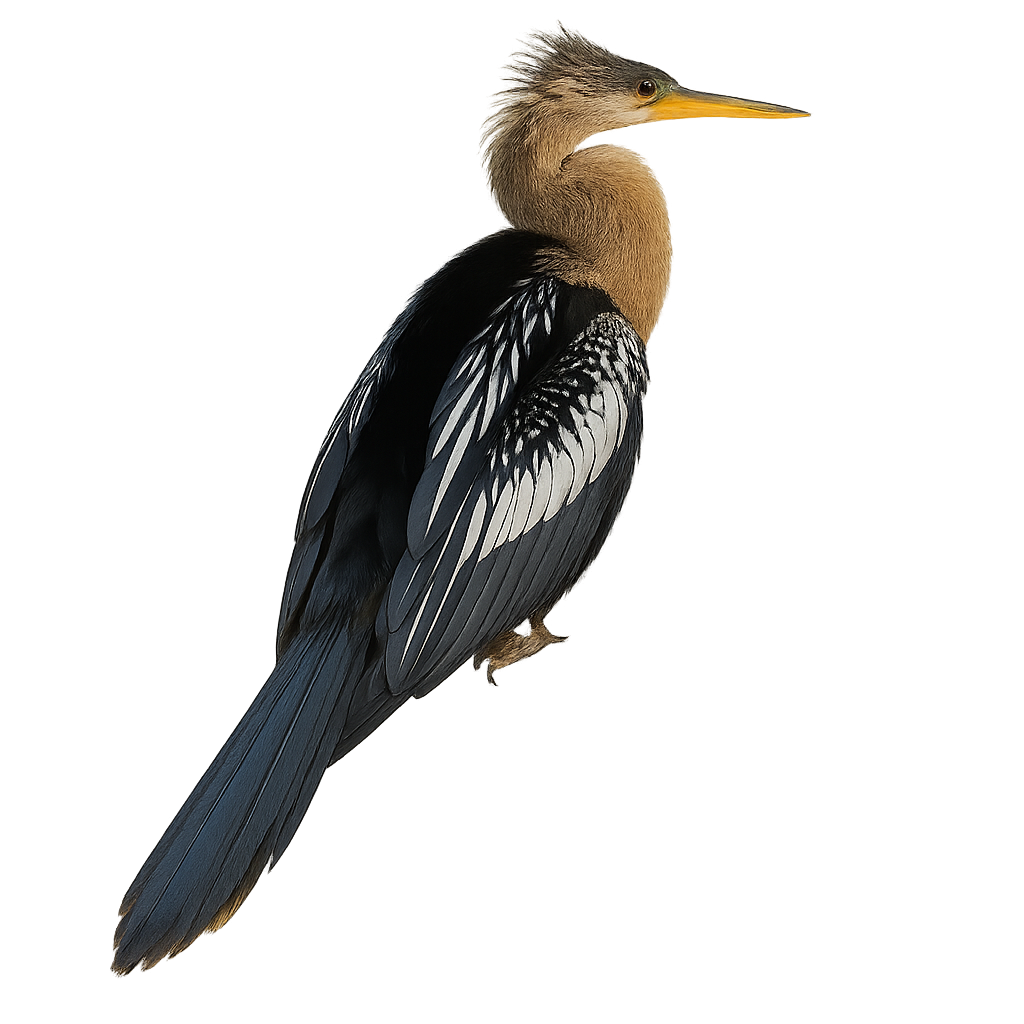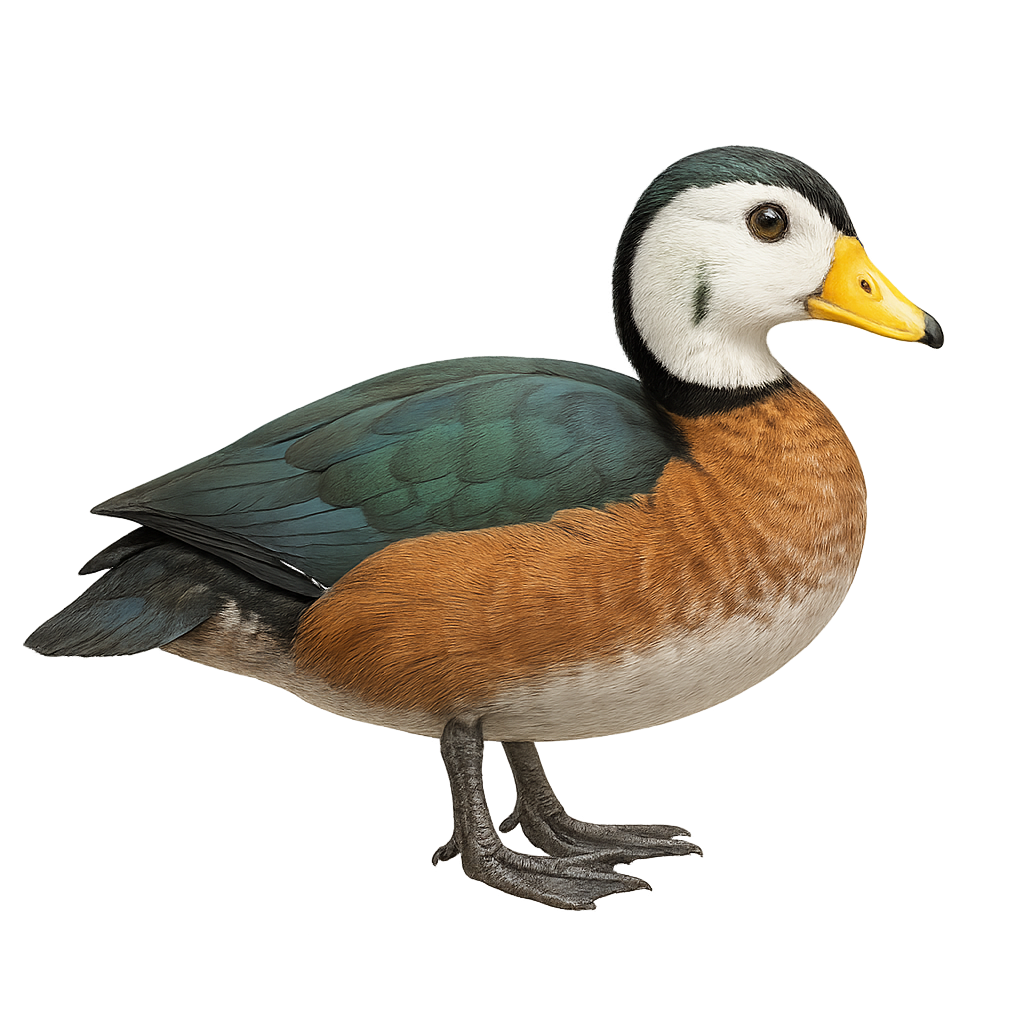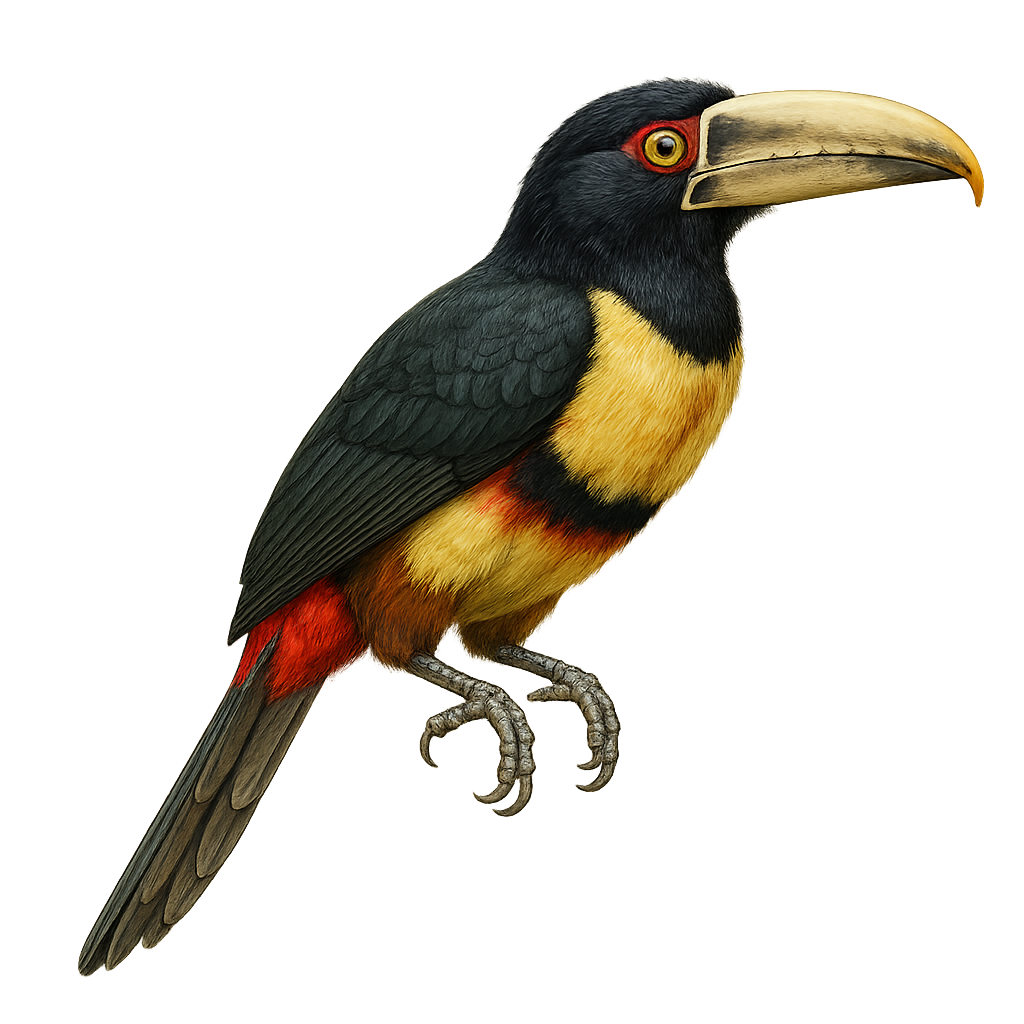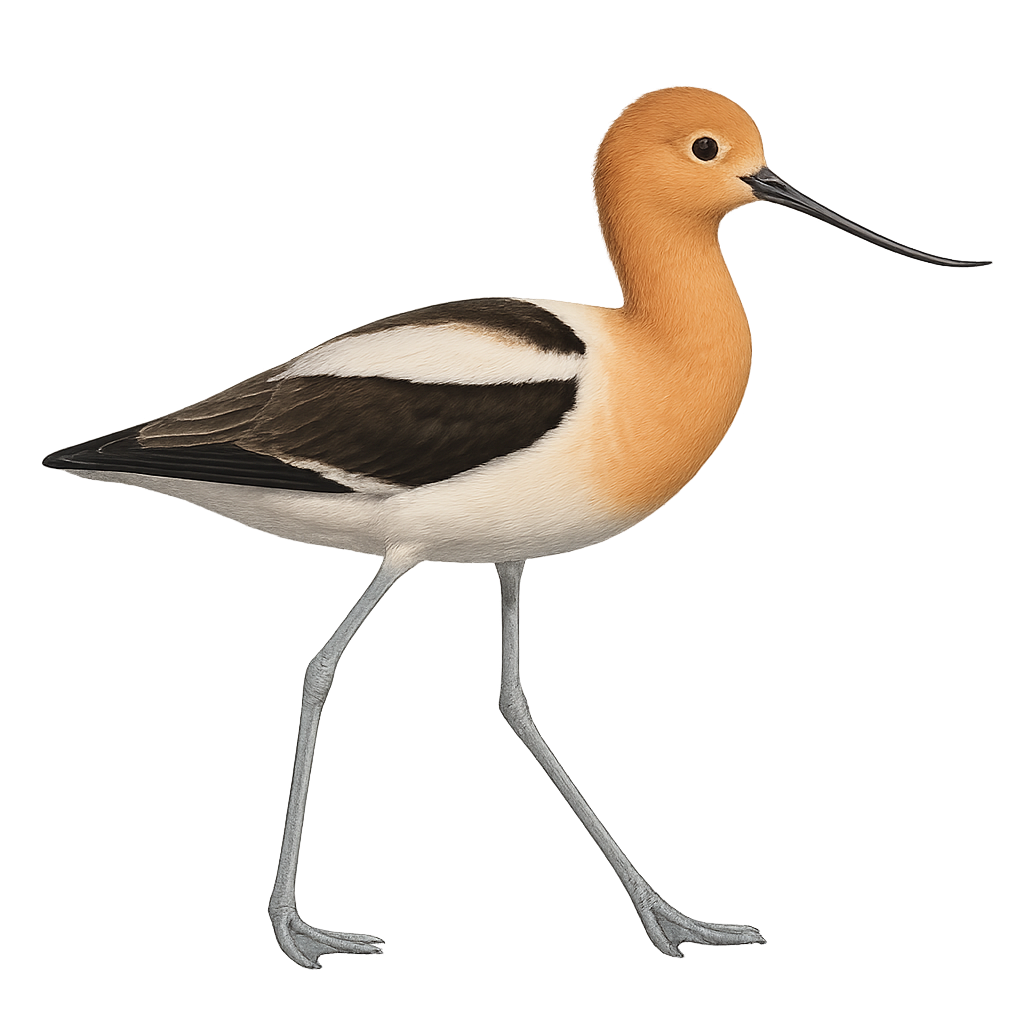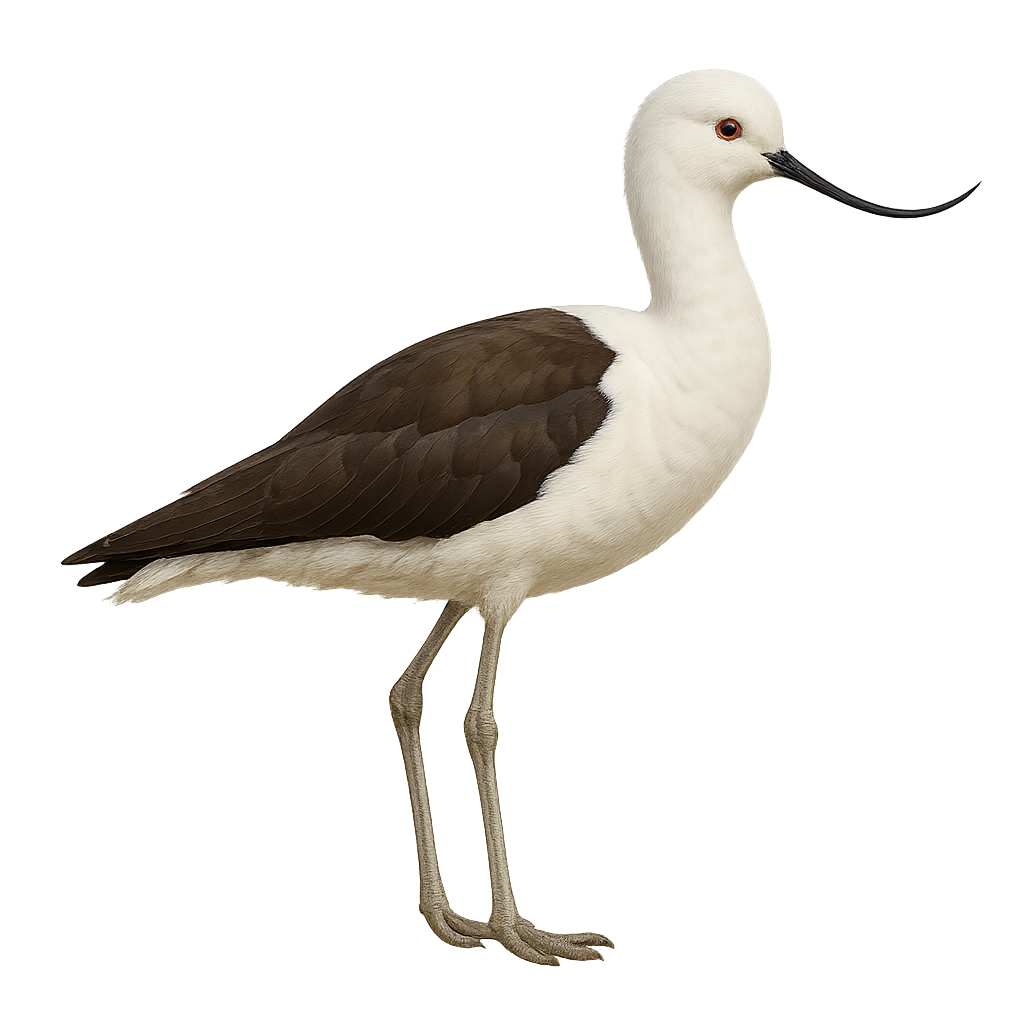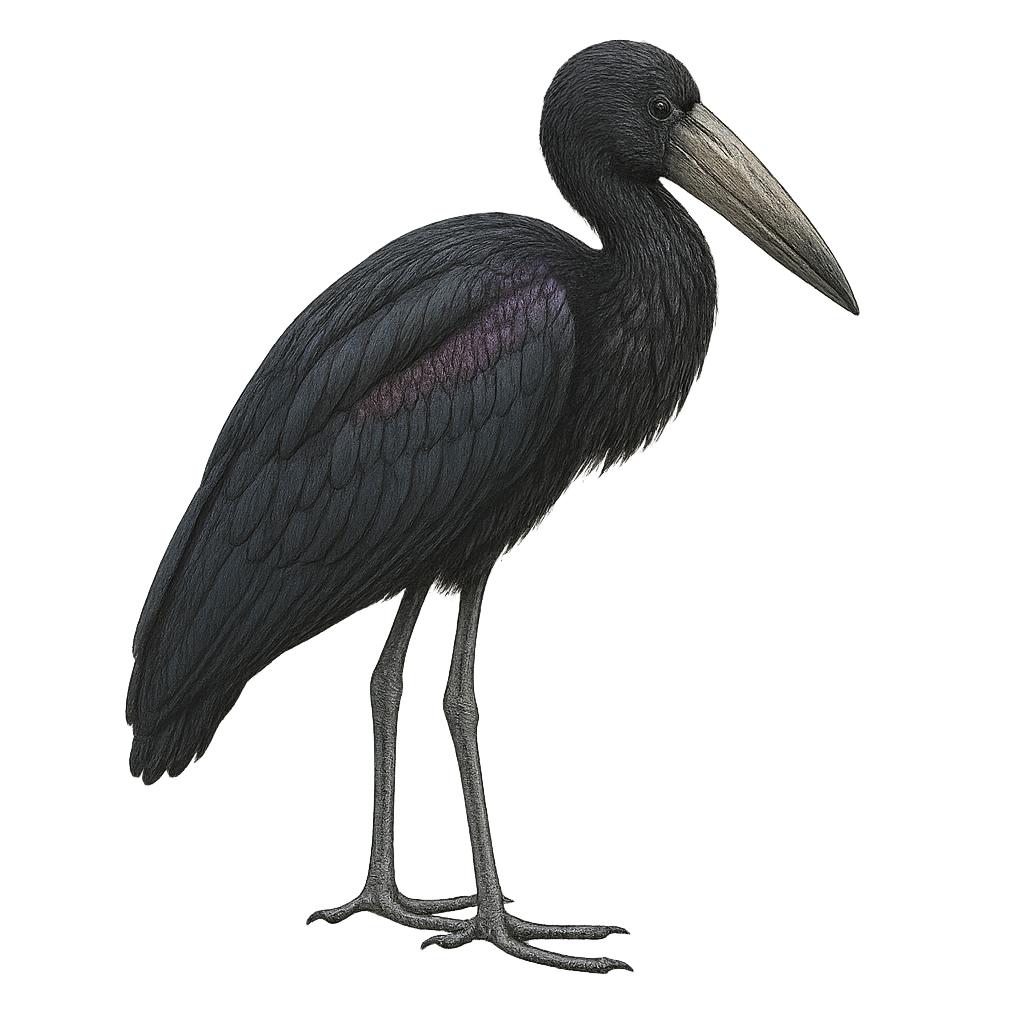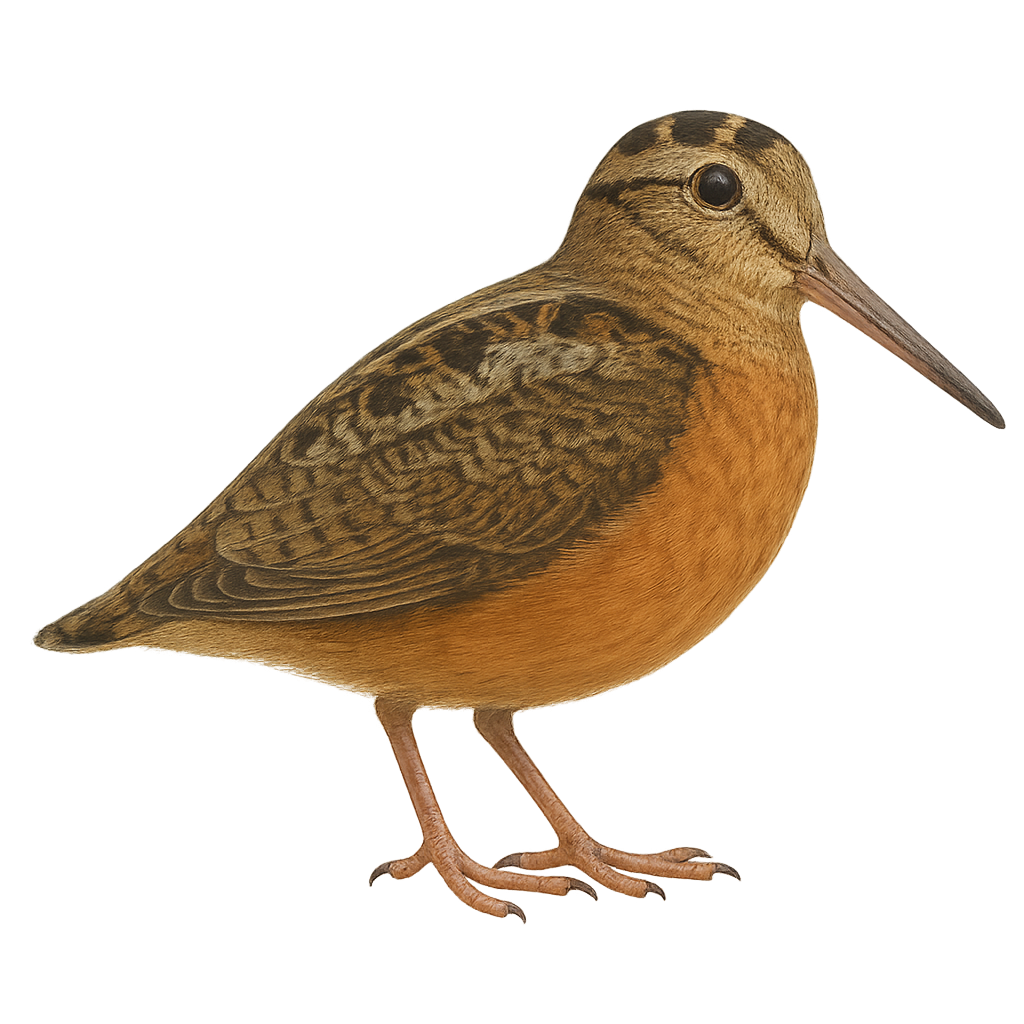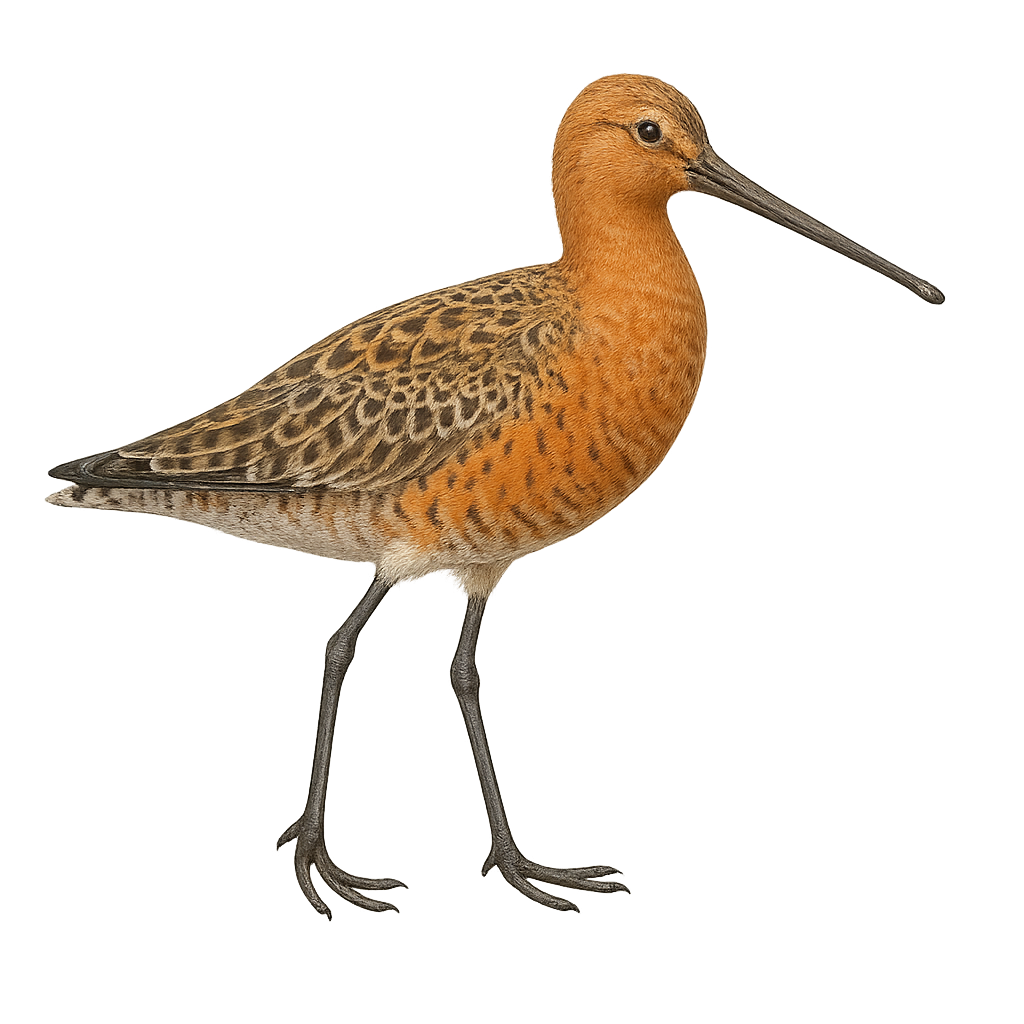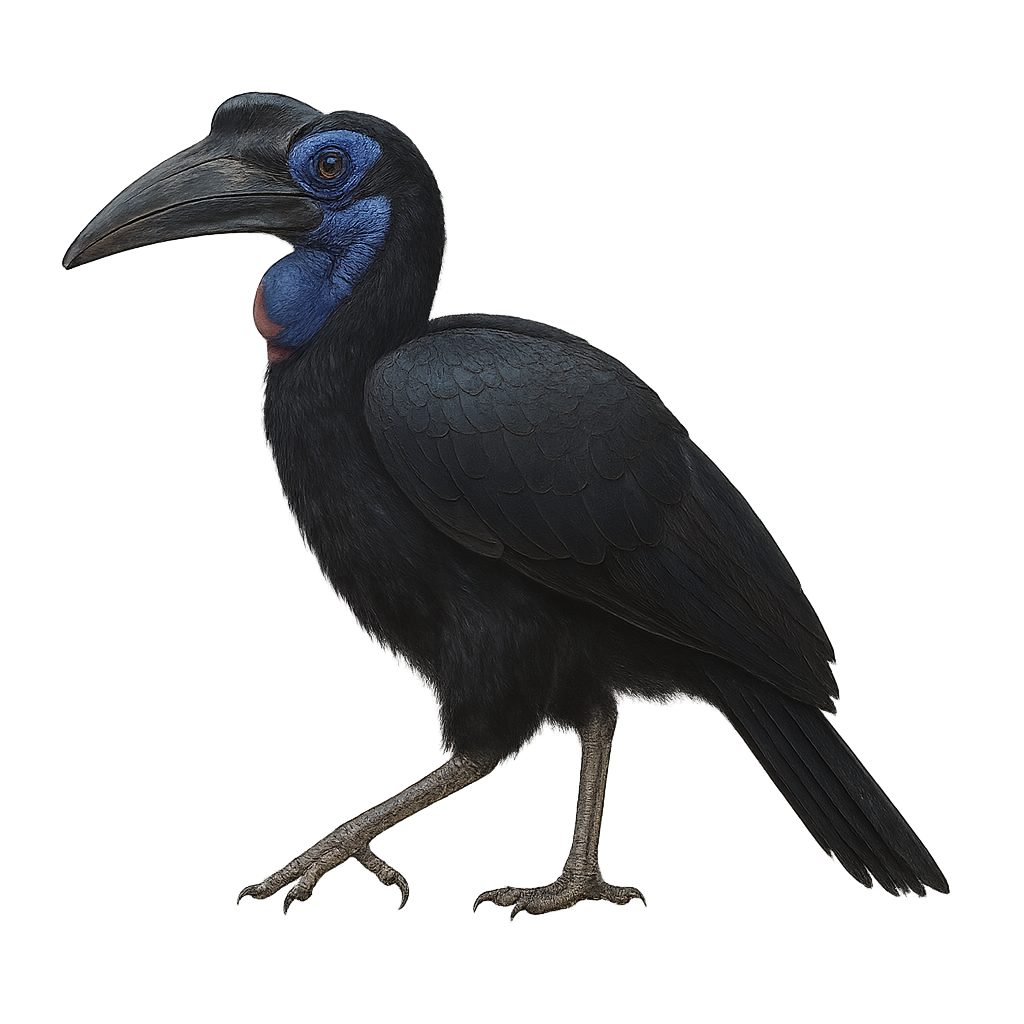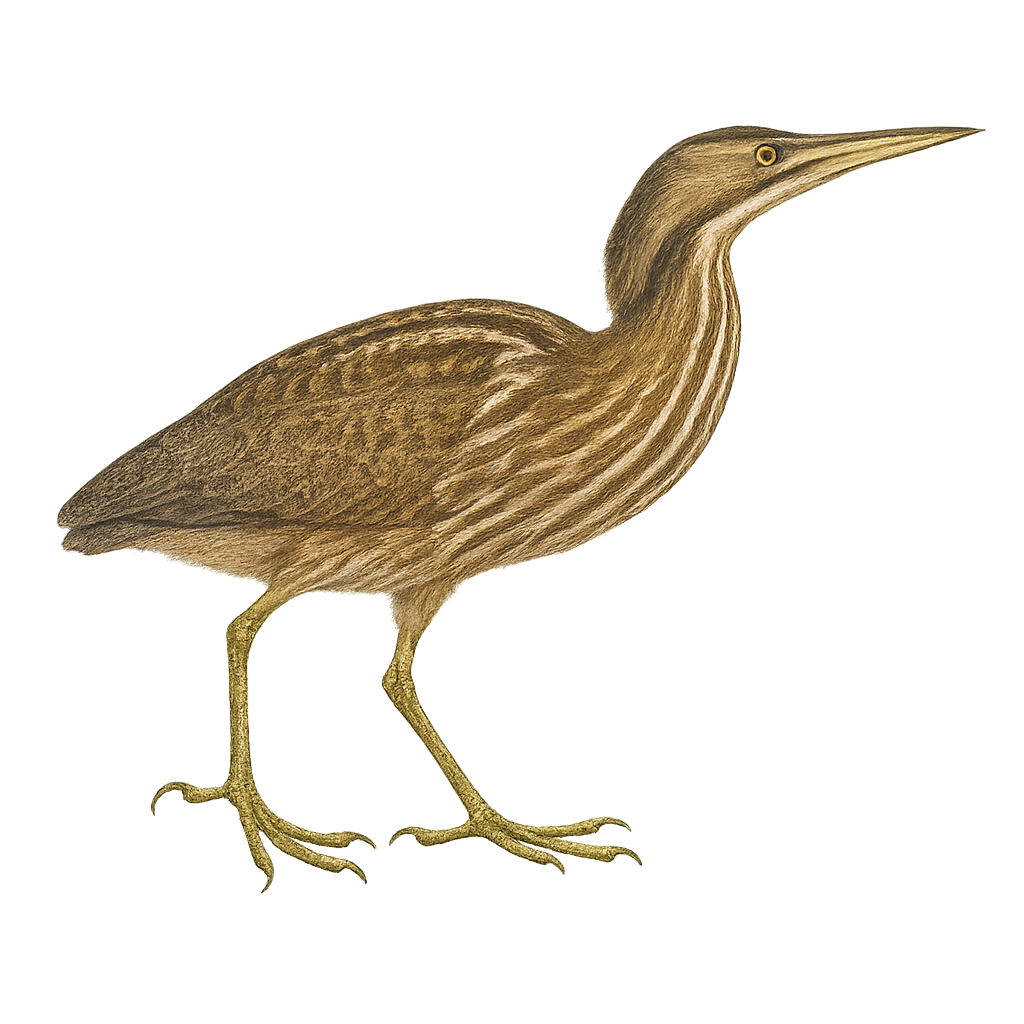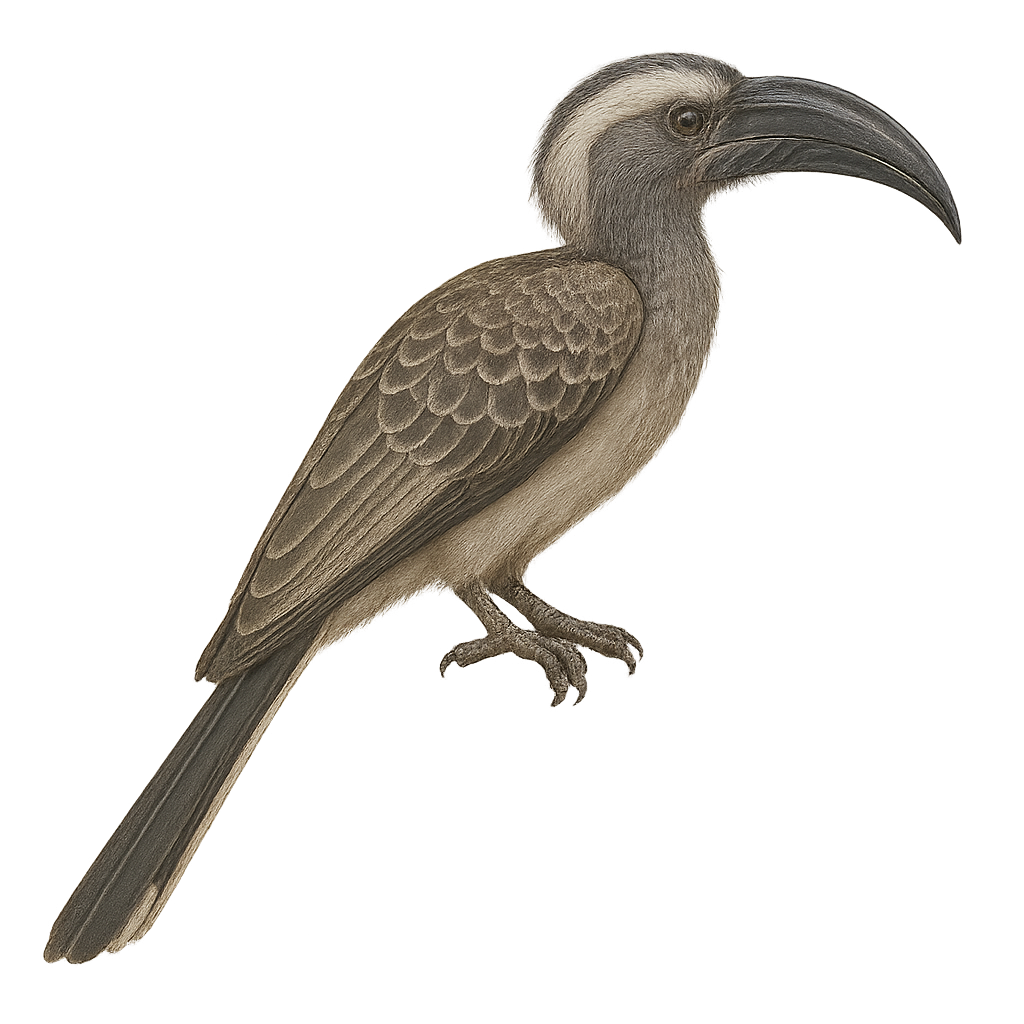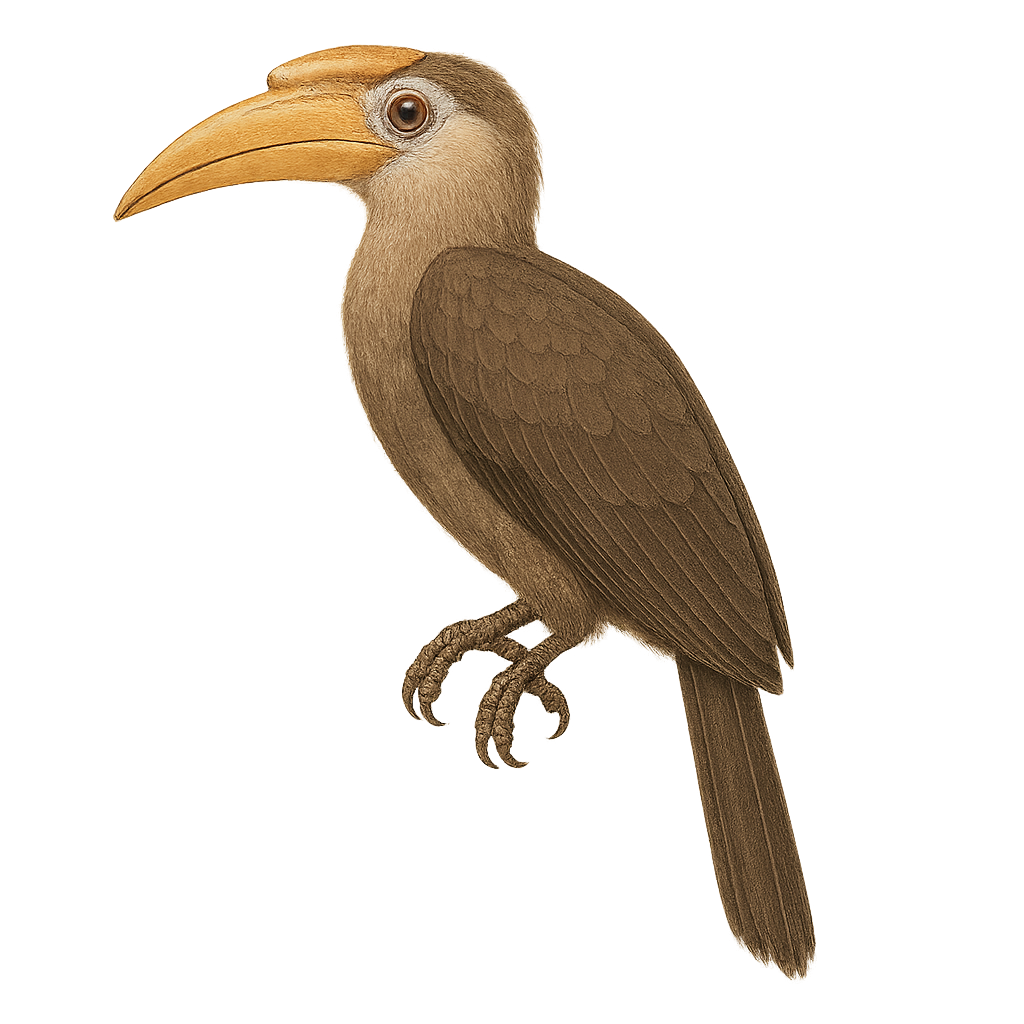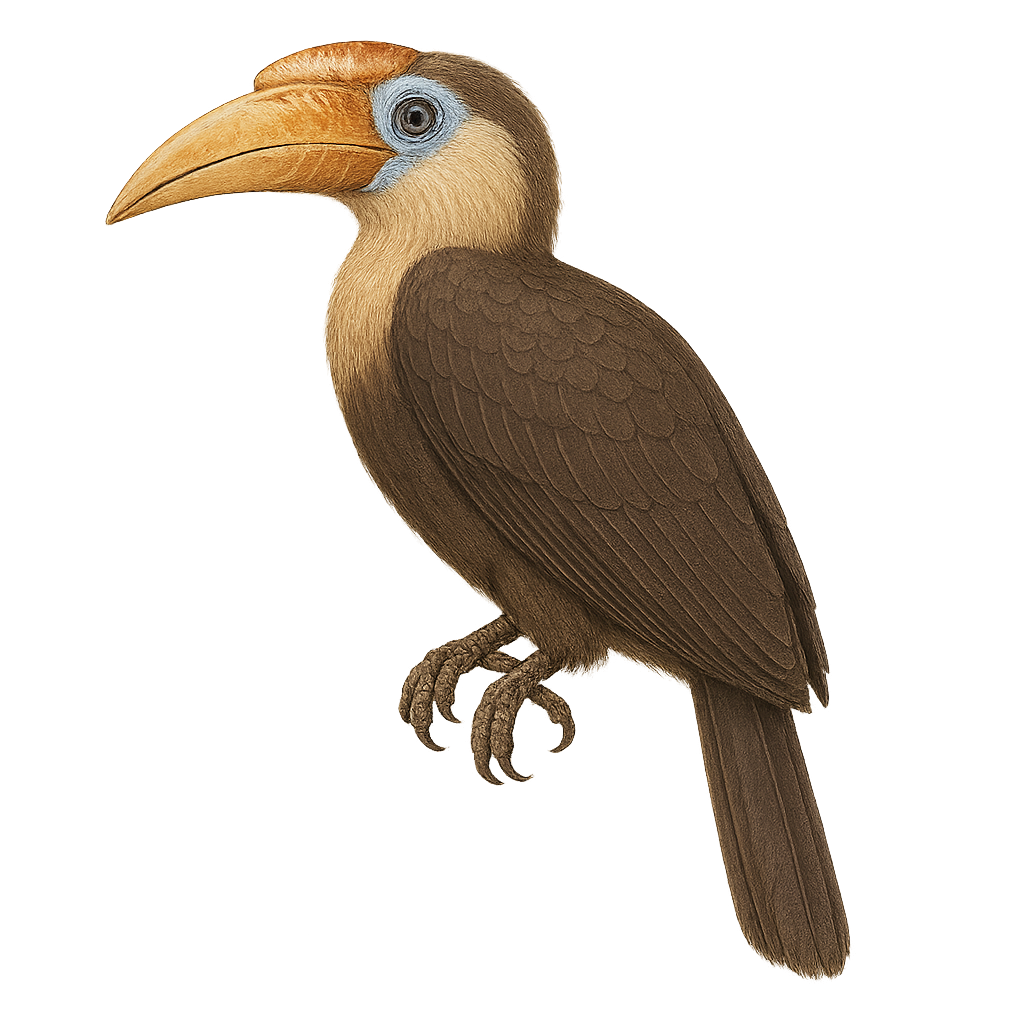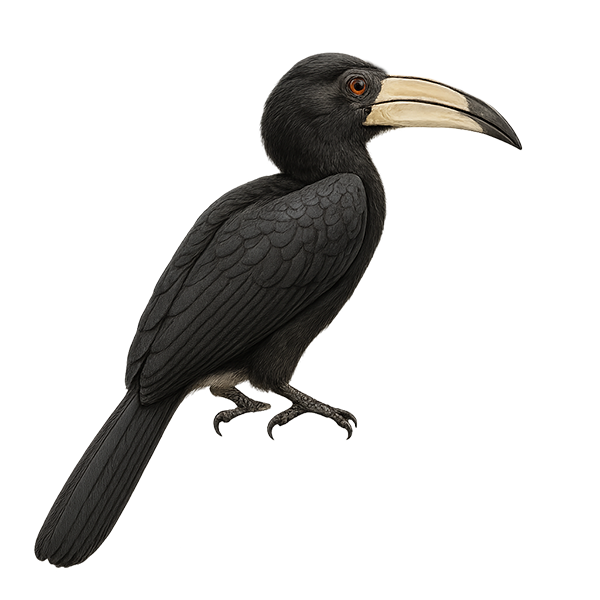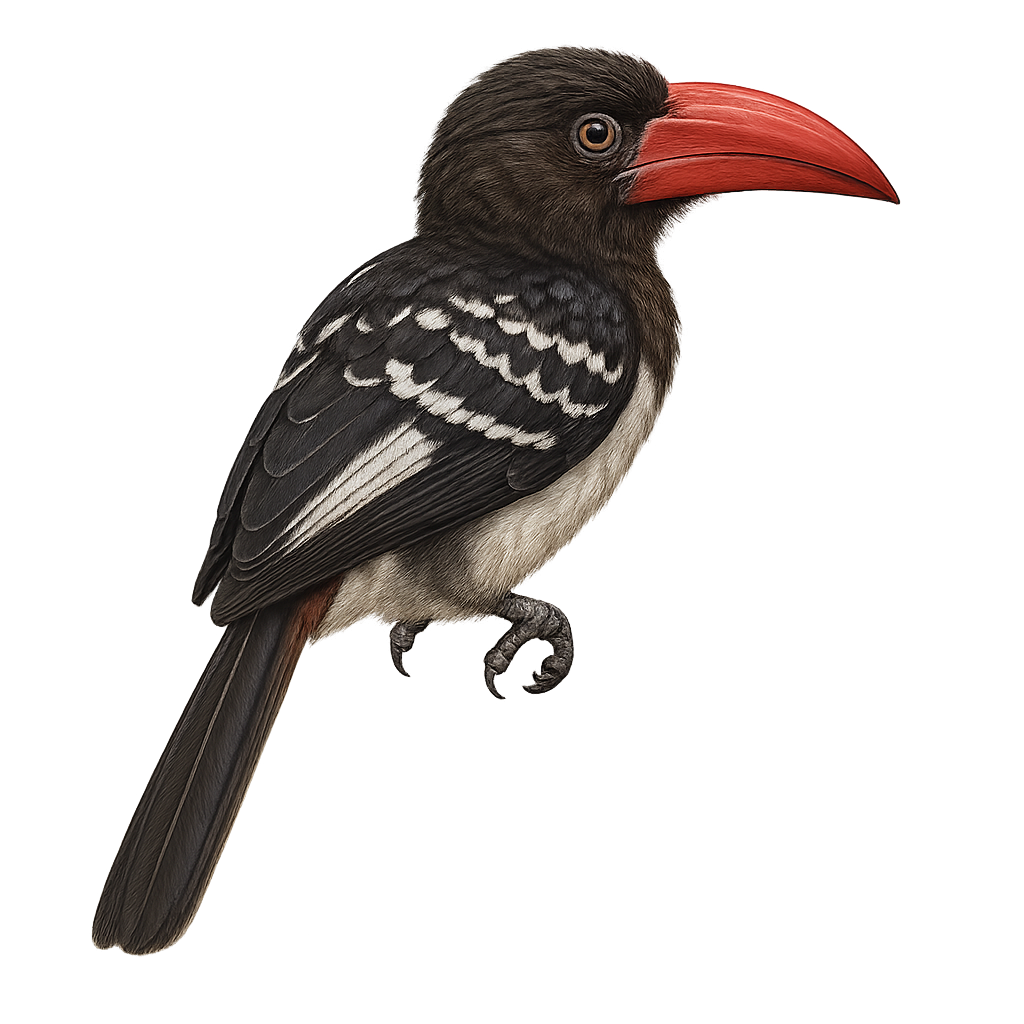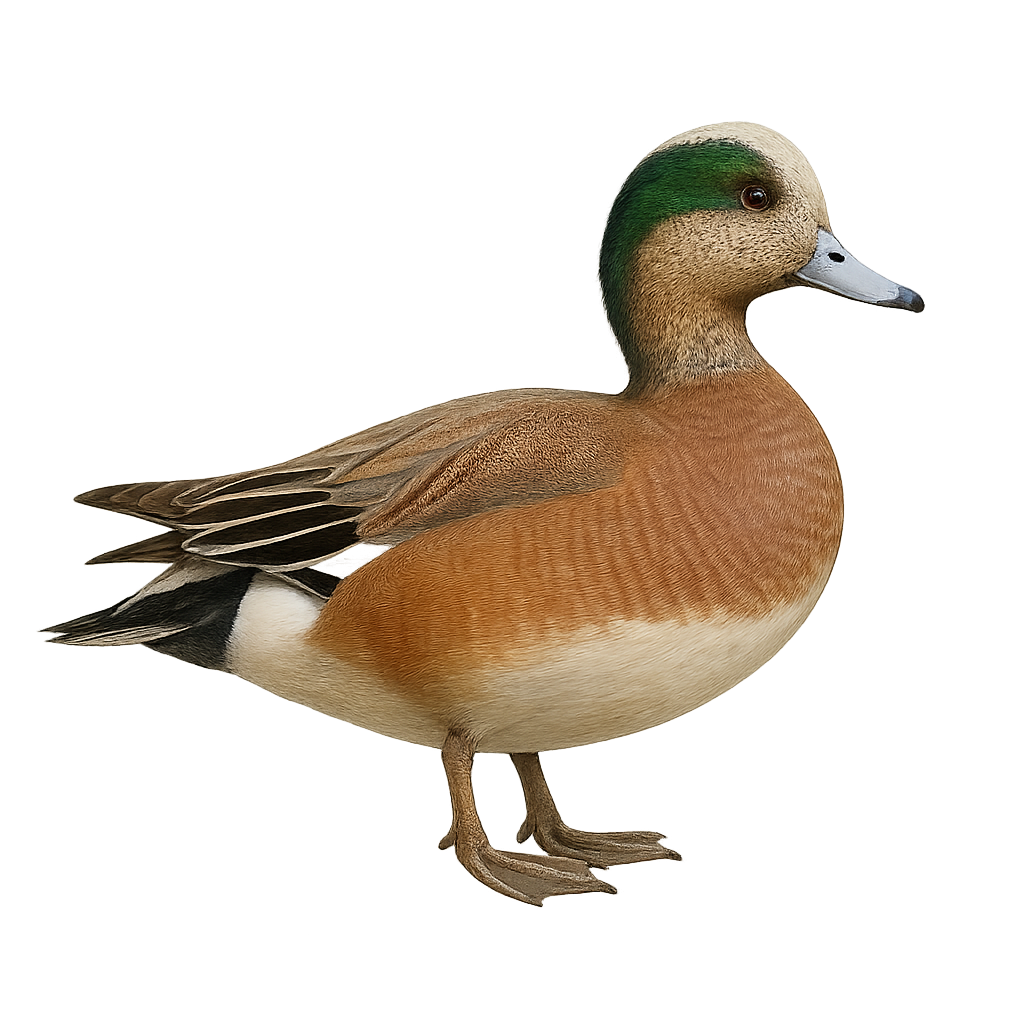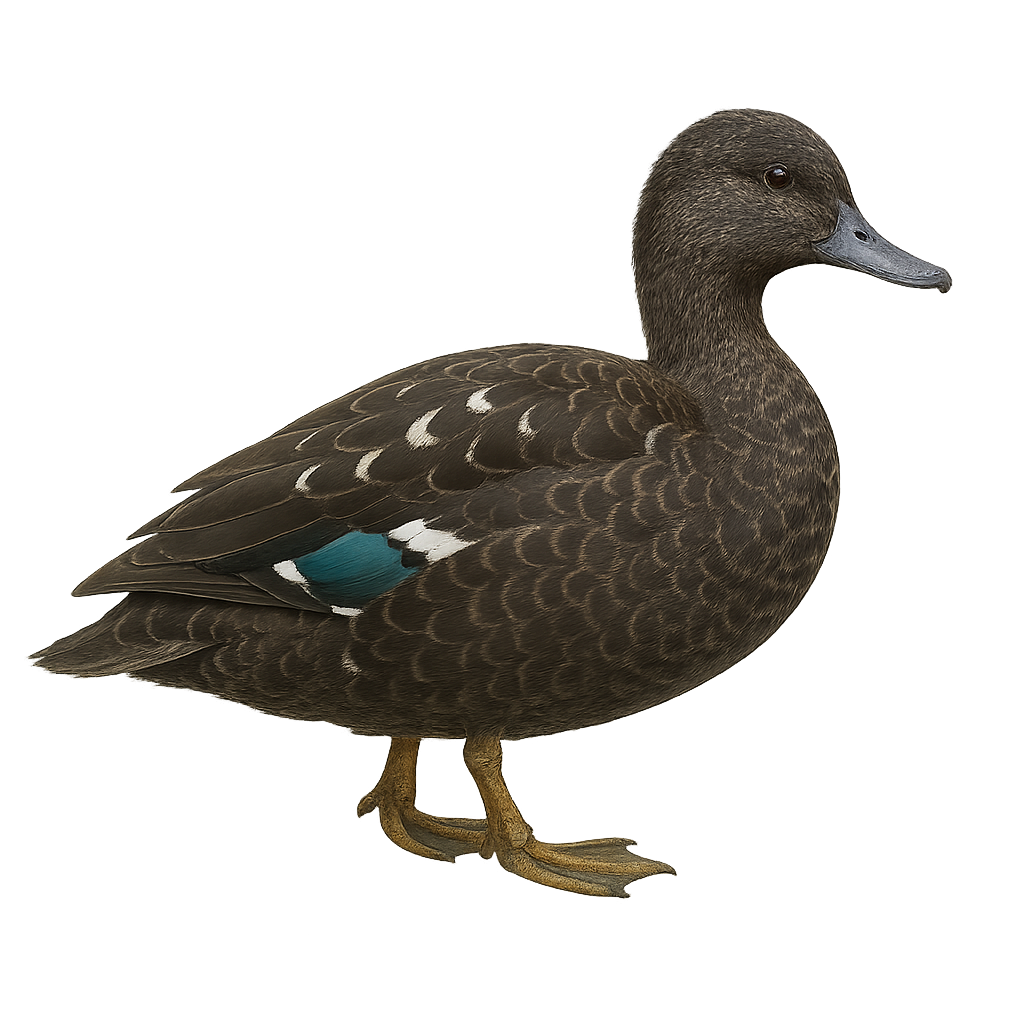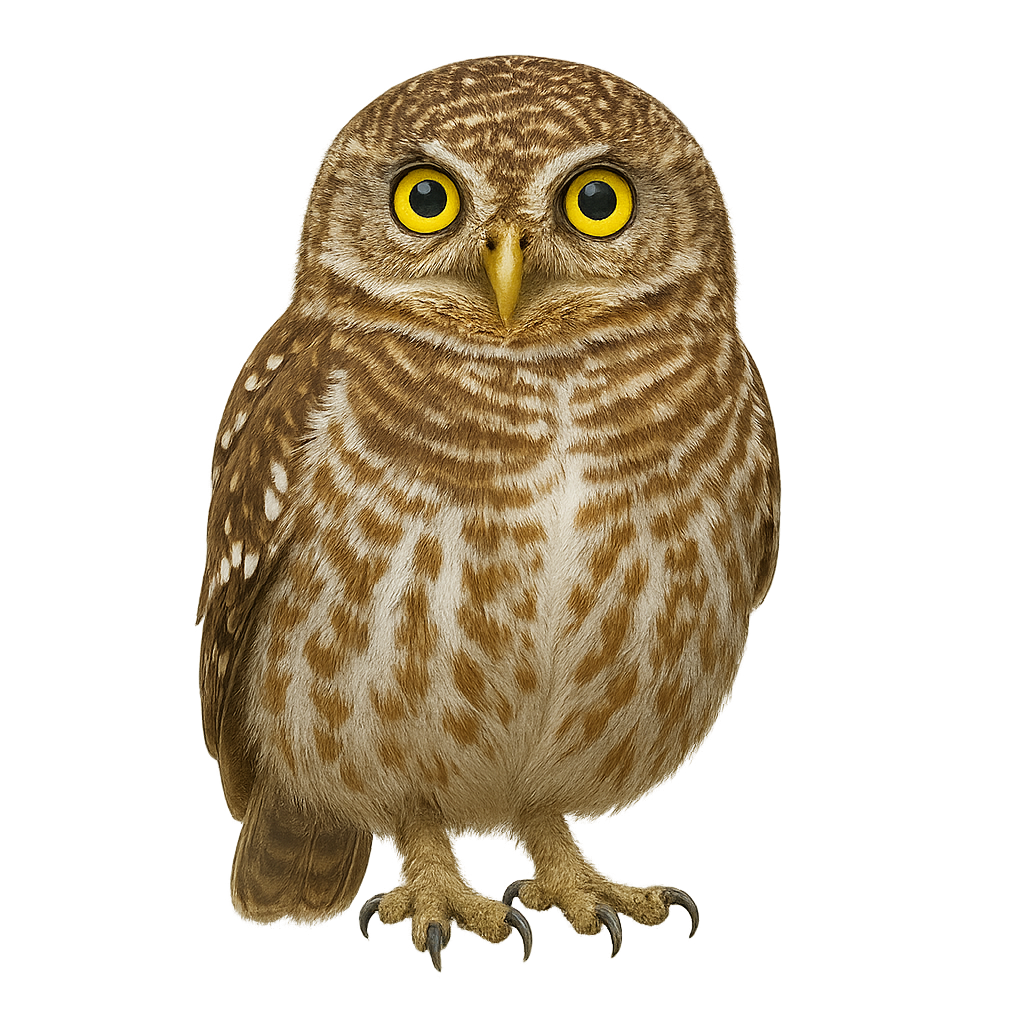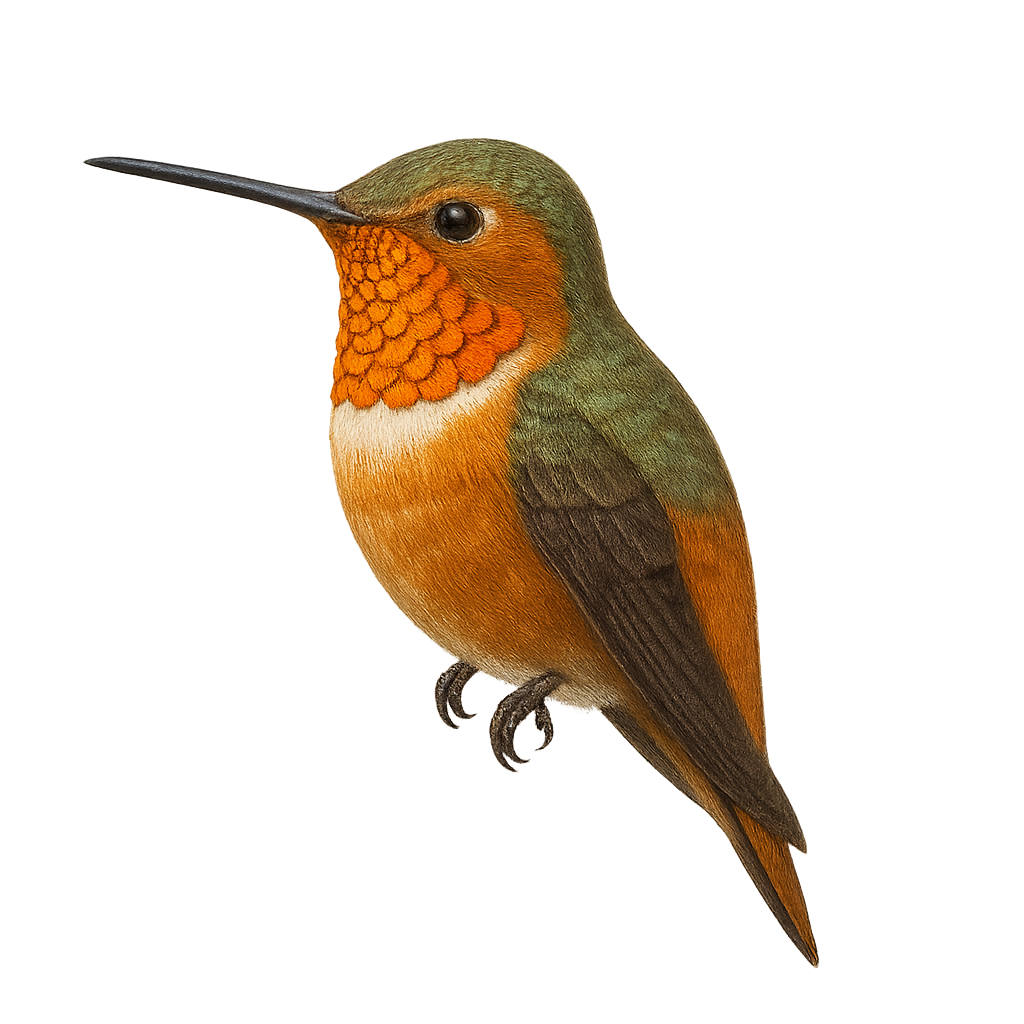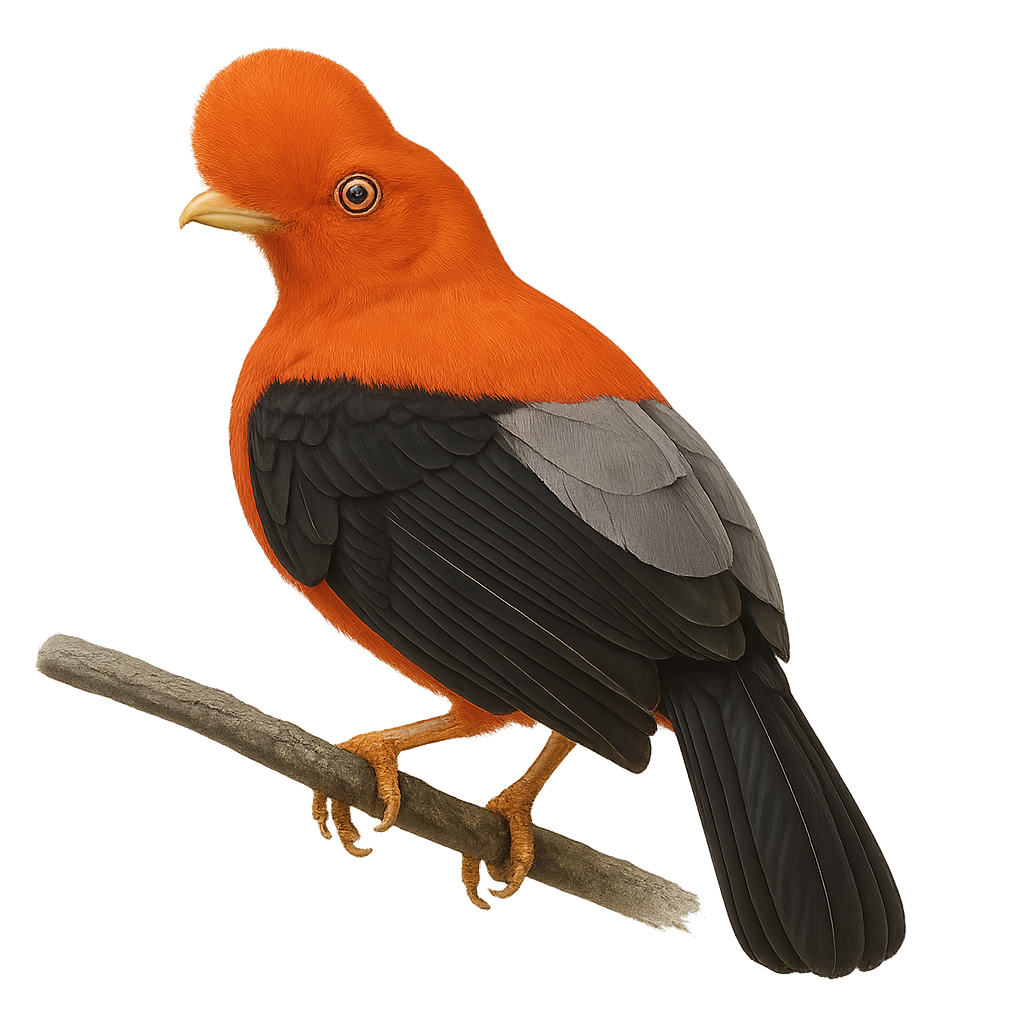The alpine accentor is a small mountain passerine, 14–15 cm long, with streaked grey-brown plumage and a slightly darker head. It inhabits alpine rocky slopes, scree, and high meadows, feeding on insects, seeds, and berries. During the breeding season, males and females establish territories and the male performs song flights to attract the female.
The Atlantic Yellow-nosed Albatross, Thalassarche chlororhynchos, is a medium-sized seabird known for its bright yellow bill and long, narrow wings. It has predominantly white plumage with dark wings and a grey head. This albatross breeds mainly on islands in the South Atlantic, forming dense colonies. It is renowned for its long gliding flights over the ocean, using air currents to travel vast distances with minimal effort. Although an excellent navigator, it is threatened by longline fishing and marine pollution.
The African Firefinch, or Lagonosticta rubricata, is a small African bird with bright red and brown plumage, often adorned with white spots on its belly. It is primarily found in savannas, open forests, and shrublands. This bird measures about 10 to 11 cm in length and weighs between 8 and 12 grams. Males and females exhibit sexual dimorphism, with males displaying brighter colors. They mainly feed on seeds but also consume insects. The African Firefinch is known for its melodious song and social behavior, often living in small groups. Its geographical range extends from West Africa to East Africa, and it is generally sedentary, although some local movements may occur depending on climatic conditions and resource availability.
The African Darter, or Anhinga rufa, is a slender waterbird known for its long, snake-like neck and dark plumage. It primarily inhabits lakes, rivers, and marshes in sub-Saharan Africa. This bird is often seen swimming with only its neck and head above water, resembling a snake. The African Darter feeds mainly on fish, which it catches with its sharp, pointed bill. After fishing, it often perches on a branch to dry its wings, as its feathers are not waterproof. This behavior is crucial for maintaining its flight capability.
The Anhinga, also known as the "snakebird," is a captivating aquatic bird. It is characterized by its long, sinuous neck and sharp beak, ideal for catching fish. Its plumage is predominantly black with metallic sheens, and its wings feature distinctive silver patterns. Unlike other water birds, the Anhinga lacks oil glands to waterproof its feathers, making it more adept at diving deep to hunt. After fishing, it must dry its wings by spreading them in the sun. It is primarily found in swamps, lakes, and rivers of Central and South America.
The Nettapus auritus, or African Pygmy Goose, is a small African duck with distinctive plumage. Males have a white head with metallic green patches, while females display more subdued tones. Their body is mainly brown with greenish reflections on the wings. These aquatic birds prefer wetlands such as marshes and shallow lakes where they feed on seeds and aquatic plants. They are often seen in small groups and are known for their fast, direct flight. Their behavior is generally suspicious, making them difficult to approach.
The Azara's Tanager is a colorful bird belonging to the toucan family. It is distinguished by its vibrant plumage, mainly black with touches of red, yellow, and green. Its long, curved beak is typical of toucans and features distinctive patterns. This bird measures about 30 to 40 cm in length. It primarily inhabits the tropical rainforests of South America, notably in Brazil, Bolivia, and Paraguay. The Azara's Tanager is a social bird, often seen in small groups. It mainly feeds on fruits but also consumes insects and small vertebrates. Although not considered threatened, deforestation poses a potential threat to its natural habitat.
The American Avocet is an elegant and distinctive bird, recognizable by its contrasting black and white plumage and its long, upward-curved bill. It primarily frequents wetlands, such as salt marshes, shallow ponds, and muddy shores. This bird is often seen sweeping the water's surface with its bill to capture aquatic invertebrates. During the breeding season, avocets form colonies and build their nests on the ground, often on islets to protect against predators. Their social behavior is fascinating, with complex courtship displays and aggressive defense of their territory. Although their population is stable, habitat destruction remains a potential threat.
The Andean Avocet, Recurvirostra andina, is an elegant and distinctive bird, recognizable by its long, upward-curving bill and slender legs. It features primarily white plumage with black wings, making it easily identifiable in its natural habitat. This bird is mainly found in the wetlands of the Andean highlands, where it feeds on small aquatic invertebrates. The Andean Avocet is a gregarious species, often seen in small groups. It is well adapted to high-altitude environments, allowing it to thrive in sometimes harsh climatic conditions. Although its conservation status is not concerning, it remains vulnerable to environmental changes and habitat degradation.
The African Openbill, or Anastomus lamelligerus, is a bird from the Ciconiidae family, predominantly found in sub-Saharan Africa. It is easily recognizable by its distinctive bill, slightly curved with a gap between the mandibles, perfect for catching snails, its primary food source. Its plumage is generally black with metallic sheens, and it has long legs adapted for walking in wetlands. It frequents marshes, rivers, and lakes, where it can be seen foraging. Although often solitary, it may gather in groups during the breeding season.
The American Woodcock, Scolopax minor, is a medium-sized bird known for its mottled brown plumage that provides excellent camouflage in the underbrush. It has a long, straight bill perfect for probing the soil for worms and insects. This bird is most active at dusk and dawn, performing its spectacular courtship displays. The American Woodcock is a partial migrant, moving southward in winter. It favors moist habitats such as deciduous forests and swamps. Although elusive, it can occasionally be spotted due to its distinctive call and acrobatic flights.
The Asian Dowitcher is a medium-sized wader bird, identifiable by its long straight bill and partially webbed feet. Its plumage is mainly brown with lighter patterns on the belly, allowing it to blend into the wetland habitats it frequents. It is often seen in coastal areas, estuaries, and salt marshes in Asia, where it feeds on small invertebrates by probing the mud with its bill. As a migratory bird, it travels long distances between its breeding sites and wintering grounds. Although its conservation status is concerning, efforts are underway to protect its habitats and ensure its survival.
The Azores Bullfinch, or Pyrrhula murina, is an endemic bird of the Azores, specifically found on the island of São Miguel. This medium-sized bird, measuring about 17 cm in length, is characterized by its grey and black plumage, with white accents on the wings. The male and female show little sexual dimorphism, although the male often has slightly brighter colors. The Azores Bullfinch is primarily granivorous, feeding on seeds, buds, and fruits. It inhabits the humid forests and wooded areas of the island, playing an important role in seed dispersal. Unfortunately, this species is critically endangered due to habitat loss and predation by introduced species.
The Abyssinian Ground Hornbill, or Bucorvus abyssinicus, is a large terrestrial bird known for its striking black plumage and vivid red markings around its eyes and neck. It is primarily found in sub-Saharan Africa, inhabiting savannas and open grasslands. This bird is notable for its social behavior, often living in small family groups. It feeds mainly on insects, small reptiles, and mammals. Its call is deep and resonant, often heard at dawn. The Abyssinian Ground Hornbill plays an important ecological role in controlling insect and small animal populations. Its longevity and low reproductive rate make it vulnerable to environmental disturbances.
The American Bittern, Botaurus lentiginosus, is a medium-sized wading bird belonging to the Ardeidae family. It is primarily found in North America, inhabiting marshes and wetlands. Its brown plumage with darker streaks provides excellent camouflage among reeds. Known for its distinctive call, often likened to a water pump, the American Bittern feeds mainly on fish, insects, and small mammals. Although elusive, it can sometimes be seen standing still, adopting a vertical posture to blend into its surroundings.
The African Grey Hornbill, or Tockus nasutus, is a medium-sized bird known for its long, curved bill, typically black with a lighter base. It features predominantly grey plumage with lighter shades on the belly and white markings on the wings. This bird is widespread in sub-Saharan Africa, inhabiting savannas, open forests, and wooded areas. It is noted for its social behavior, often seen in small groups or pairs. The African Grey Hornbill primarily feeds on fruits, insects, and occasionally small vertebrates. Its call is distinctive, consisting of nasal cries and whistles.
The Austen's Brown Hornbill, or Anorrhinus tickelli, is a medium-sized hornbill found in dry forests and wooded hills of Southeast Asia, especially in Myanmar, Thailand, and western Laos. It is identified by its uniformly dark brown plumage, contrasting black-and-white tail, and dark bill without a prominent casque. Highly social, it moves in family groups and is often noisy, producing harsh calls and barking sounds. It feeds on fruits, insects, and occasionally small vertebrates. Although somewhat tolerant of disturbed areas, this hornbill is vulnerable to deforestation.
The Austen's Brown Hornbill, Anorrhinus austeni, is a captivating bird belonging to the Bucerotidae family. This medium-sized hornbill is notable for its brown plumage and distinctive white tail band. Males and females exhibit sexual dimorphism, with males having larger, more curved bills. These birds primarily inhabit the tropical rainforests of Southeast Asia, feeding on fruits, insects, and small vertebrates. Known for their social behavior, they often live in family groups. Nesting occurs in tree cavities, where the female is sealed in during incubation. Although their population is stable, deforestation poses a threat to their natural habitat.
The African Pied Hornbill, or Tockus fasciatus, is a striking bird known for its black and white plumage and distinctive silver cheeks. Found mainly in West Africa, it inhabits tropical forests and wooded savannas. Its diet consists mainly of fruits, insects, and small vertebrates. Known for its social behavior, the hornbill is often seen in small groups or pairs. It nests in tree cavities, where the female is sealed in during incubation. The male provides food until the young are ready to leave the nest. This species plays a crucial role in seed dispersal, contributing to the health of forest ecosystems.
The African Dwarf Hornbill, or Lophoceros camurus, is the smallest hornbill species in Africa. It is easily recognized by its glossy black plumage, white belly, and large curved red bill with no casque. It inhabits the humid tropical forests of Central Africa, especially in Cameroon, Gabon, the Republic of the Congo, and northern DRC. It forages mainly in the canopy, feeding on fruits, insects, and small vertebrates. Though discreet, it is active and often seen in pairs or small family groups. While understudied, it appears locally common but remains vulnerable to habitat loss.
The Australian Wood Duck, Chenonetta jubata, is a waterfowl native to Australia, known for its distinctive plumage and crest of feathers on its head. Males have a dark brown head and grey body, while females display a more subdued plumage with speckled patterns. These ducks prefer wetlands, rivers, and lakes but can also be found in grasslands and urban parks. They primarily feed on aquatic plants, seeds, and insects. Their social behavior is interesting, as they often form family groups. Although generally tolerant of humans, they can become wary if disturbed.
The American Wigeon, Mareca americana, is a dabbling duck species known for its striking plumage and feeding habits. The male features an iridescent green head with a distinctive white forehead stripe, while the female has a more subdued brown-gray plumage. These ducks are commonly found in wetlands, lakes, and marshes, feeding primarily on aquatic plants. They are migratory, spending summers in northern North America and wintering further south. Their flight is fast and direct, often seen in large flocks. Although generally wary, they can become accustomed to human presence in protected areas.
The African Black Duck, or Anas sparsa, is a medium-sized waterfowl known for its dark plumage and distinctive white wing markings. This duck is often found in fast-flowing rivers and streams in the mountainous regions of sub-Saharan Africa. Well adapted to its environment, it prefers swift waters where it can dive for small invertebrates and aquatic plants. Its discreet behavior and dark coloration allow it to blend into the shadows of waterways, making it difficult to spot. Although generally solitary or in small groups, it can sometimes be seen in pairs, especially during the breeding season.
The Andean Pipit, or Catamenia analis, is a small passerine bird found mainly in the mountainous regions of South America. It is recognizable by its brownish-grey plumage with dark streaks on the back and a lighter chest. This bird is well adapted to high altitudes, often seen between 1000 m and 4000 m. It primarily feeds on seeds and insects, which it finds by foraging on the ground. The Andean Pipit is a relatively discreet bird, but its melodious song can be heard during the breeding season. It builds its nest on the ground, hidden among grasses and shrubs.
The Alpine Chough, or Pyrrhocorax graculus, is a mountain bird from the Corvidae family. It is recognized by its glossy black plumage, bright yellow bill, and red legs. This bird is often seen in the Alps and the Pyrenees, where it moves in noisy flocks. Exceptionally agile in flight, it can skillfully maneuver in updrafts. Opportunistic, it feeds mainly on insects, fruits, and food scraps left by hikers. The chough is a sociable bird, often not very shy, and easily approaches humans. It nests in rock crevices and cliffs, usually laying three to five eggs.
The Asian Barred Owlet, or Glaucidium cuculoides, is a small nocturnal bird of prey belonging to the Strigidae family. It is mainly found in South and Southeast Asia, particularly in the forests of the Himalayas, from northern India to China and Indonesia. It is characterized by its brown plumage with white bars on the chest and wings, and its piercing yellow eyes. Measuring about 22 to 25 cm in length, it is known for its distinctive call that resembles that of a cuckoo. It primarily feeds on insects, small mammals, and birds. The Asian Barred Owlet is a discreet bird, often difficult to spot due to its plumage that blends perfectly with its forest environment.
The Abdim's Stork, scientifically known as Ciconia abdimii, is a bird species belonging to the Ciconiidae family. It is easily identifiable by its black and white plumage, grey bill, and red legs. This stork is mainly found in sub-Saharan Africa, where it inhabits savannas, grasslands, and wetlands. It is migratory and moves in large colonies. The Abdim's Stork feeds primarily on insects, small reptiles, and amphibians. It is known for its social behavior and tolerance of human presence. Although its conservation status is currently "least concern," it remains vulnerable to environmental changes and habitat loss.
The Allen's Hummingbird, or Selasphorus sasin, is a small, vibrant bird primarily found along the western coast of North America. This hummingbird is known for its striking plumage, featuring copper and green hues. Males display a brilliant reddish-orange throat, while females and juveniles are more subdued with green and white tones. These birds are renowned for their rapid and agile flight, often seen hovering around flowers to feed on nectar. They play a crucial role in pollination. The Allen's Hummingbird is also famous for its seasonal migrations, traveling between breeding grounds and wintering areas.
The Andean condor is one of the largest flying birds in the world, known for its impressive wingspan reaching up to 3.3 meters. It primarily inhabits the Andean mountains, where it feeds on animal carcasses. Its majestic flight and habit of soaring at high altitudes make it a fascinating subject for photographers. Although protected, the Andean condor is threatened by habitat loss and poisoning from consuming contaminated carcasses.
The Andean Cock-of-the-rock, Rupicola peruvianus, is a striking bird found in the humid forests of the Andes. The male is known for its vibrant orange plumage, while the female is more subdued with brownish tones. This bird is famous for its elaborate courtship displays, where males gather in leks to perform dances and distinctive calls to attract females. Primarily frugivorous, it plays a crucial role in seed dispersal, aiding in the regeneration of its habitat. Although currently listed as "Least Concern," deforestation and habitat loss pose potential threats to its survival.



